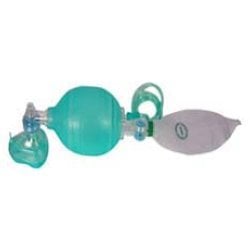
Problem being addressed[edit | edit source]
Every year an estimated 4 million babies die in their first four weeks of life. Birth asphyxia (when a baby does not breathe at birth) is the third most common cause of newborn deaths. Limited data suggest that deaths due to birth asphyxia have remained relatively unchanged in developing countries.
Detailed description of the solution[edit | edit source]
This device was designed for babies with little to no breathing. This bag-and-mask medical silicone resuscitator is ideal for use in developing countries because of its low cost of production and reusability. It may be reused and is designed for assembly and disassembly. The resuscitator also has a pressure-limiting valve that reduces risk of lung rupture, an oxygen reservoir bag, and an oxygen tubing connector. The current resuscitator on the market is the Merlin Medical Autoclavable Resuscitator, which comes in three sizes: 240 mL (Infant), 500 mL (Child), and 1600 mL (Adult). It is 100% latex free and can tolerate temperatures of up to 125 degrees Celsius when being sterilized. A pressure release valve is in the 240 mL and 500 mL resuscitators to minimize the risk of over-inflating the lungs, but the valve can be locked as well.
Manufacturing[edit | edit source]
- This device is manufactured by numerous companies in various forms.
- Main location of manufacturing: New Delhi, India.
When and where it was tested/implemented[edit | edit source]
In 1956, the Danish company Ambu A/S created the first non-electric, self-inflating resuscitator. Now different versions of this resuscitator is currently being used in both developed and developing countries.
References[edit | edit source]
Peer-reviewed publication[edit | edit source]
Gausche, M., Lewis, R., Strattor, S., & al, e. (2000). Effect of Out-of-Hospital Pediatric Endotracheal Intubation on Survival and Neurological Outcome. The Journal of the American Medical Association, 283(6), 783-790. Article available here.
Internally generated reports[edit | edit source]
Emergency Care - medical devices for emergency situations. (n.d.). Ambu USA - Ideas that work for life. Link available here.
Externally generated reports[edit | edit source]
MidMeds. (2010). Merlin medical silicone resuscitator. Link available here.
Seamans, Y. (n.d.). Neonatal resuscitators can reduce newborn deaths. Link available here.
Approval by regulatory bodies or standards boards[edit | edit source]
This device is FDA-approved for the market. Link available here.